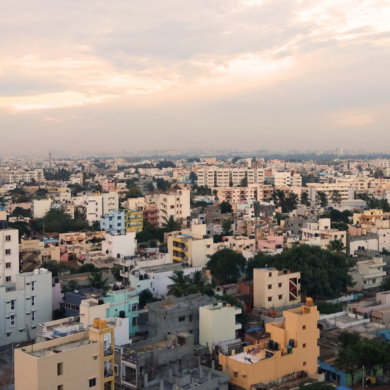TDS on Purchase of Property: A Complete Guide for Buyers
December 28th, 2024

This blog explains TDS on purchase of property – including its applicability, calculation, compliance process, deadlines, and benefits – helping you ensure smooth, legally compliant, and hassle-free real estate transactions.
Navigating the complexities of real estate transactions involves understanding various tax obligations, one of which is TDS on purchase of property. As per Section 194-IA of the Income Tax Act, ensuring compliance with the TDS on property purchase above 50 lakhs section protects buyers from penalties and legal complications. This provision ensures compliance with Indian tax laws and prevents potential penalties.
This blog aims to demystify TDS on purchase of immovable property – explaining the process, applicable rates, and timelines. By understanding how to pay TDS on purchase of property, you can ensure a seamless property transaction while meeting all legal requirements as a buyer.
Table of Contents
Why it is Important for Buyers to Understand TDS on Purchase of Property
Being aware of how TDS applies to your purchase safeguards you from compliance issues and ensures smooth ownership transfer. It reduces complications and accelerates the buying process.
With precise tax deductions and proper documentation, you can focus on securing your dream home rather than dealing with compliance setbacks. Staying informed on TDS on purchase of immovable property not only protects your investment, but also enhances your confidence as a buyer.
What is TDS on Purchase of Property?
The Indian Income Tax Act’s Section 194-IA mandates that buyers deduct 1% TDS on purchase of immovable property, when the transaction value exceeds ₹50 lakh. TDS on purchase of immovable property must be deposited with the government within 30 days of deduction, ensuring transparency in high-value property transactions.
- Applicability ThresholdThis provision applies to all property purchases except agricultural land. Under the TDS on property purchase above 50 lakhs section, agricultural land transactions are exempt from tax deduction.
- Exclusions and ExemptionsAgricultural Land: Transactions involving agricultural land are excluded from TDS applicability
Other Exemptions: Properties not exceeding the ₹50 lakh threshold are also exemptBy understanding these provisions of TDS on purchase of immovable property, buyers can streamline the process, avoid penalties, and ensure compliance while safeguarding their investment.
When is TDS on Purchase of Property Applicable?
TDS is applicable when the transaction value of property purchase exceeds ₹50 lakh; paying this tax is the buyer’s responsibility. The deducted amount should be filed with the government using Form 26QB, within 30 days of deduction.
Once the payment is deposited, buyer must download Form 16B and provide it to the seller as proof of compliance. This process not only ensures adherence to tax laws, but also facilitates a smooth and legally compliant property transaction.
Case Studies: Full Payment vs. Instalment Payments
In cases of full payments, TDS is calculated on the total consideration amount, while for instalment payments, TDS must be deducted on each instalment that exceeds the threshold value.
- Full Payment Scenario
Example: A buyer purchases a property for ₹70 lakh
TDS Calculation: The buyer must deduct 1% of ₹70 lakh, which amounts to ₹70,000
Payment Timeline: According to the TDS on property purchase above 50 lakhs section, buyers must deposit the deducted amount within 30 days of deduction
Compliance: The buyer should file Form 26QB to report this deduction, and provide Form 16B to the seller as proof of TDS deduction - Instalment Payment Scenario
Example: A buyer purchases an under-construction property for a total of ₹80 lakh, with payments structured in instalments over many months.
TDS Calculation: Under the TDS on property purchase above 50 lakhs section, buyers must deduct 1% TDS on each instalment payment that contributes to the property transaction value exceeding ₹50 lakh.
For instance, if the first instalment of ₹30 lakh is paid, TDS is required since the total value exceeds ₹50 lakh. Even if a subsequent instalment of ₹10 lakh is made, the buyer must deduct 1% of ₹10 lakh, which equals ₹10,000.
Payment Timeline: TDS must be deposited within 30 days of deduction of 1% of the transaction value.
Compliance: Like full payments, Form 26QB needs to be filed for each relevant instalment where TDS is deducted.
How to Calculate the TDS amount?
Understanding TDS deduction on property purchases ensures compliance. Verify the seller’s PAN, calculate TDS, deposit it timely, and use online tools for simplified management. Follow the steps described below, to know your TDS amount.
- Step 1: Determine the Property Value
Identifying the property’s value is the first step. This is the sum that the buyer and seller have agreed upon. TDS on purchase of immovable property should be computed using this value. - Step 2: Calculate the TDS Amount
TDS on purchase of a property is calculated at 1% of the property value. If the property value is ₹70 lakh, then the TDS amount will be ₹70,000 which is 1% of ₹70 lakh. - Step 3: Verify the PAN Information
You must verify the seller’s PAN information before paying them. Only if the seller holds a PAN, it is required to deduct TDS from the acquisition of real estate. TDS is deducted at a rate of 20%, if PAN is not available. - Step 4: Deposit the TDS
Within 30 days of the TDS deduction, the amount must be remitted to the government. Through the relevant govt website, you can deposit the TDS amount online. - Step 5: Obtain a TDS certificate
The deposit of the TDS amount is attested to, by this document. This certificate is available for download on the official TDS website of the government of India.
Using a TDS Calculator for Ease
Alternatively, you can learn how to pay TDS on purchase of property with a TDS calculator. Using the property valuation and the seller’s PAN information, this online application assists you in calculating TDS on any real estate acquisition.
In this property TDS calculator, enter the property’s worth and the seller’s PAN information, and the calculator will tell you how much TDS must be subtracted. This tool is useful if you are wondering how to pay TDS on purchase of property.
Step-by-Step Process to Pay TDS on Property Purchases
This is a mandatory requirement under the Income Tax Act. Following the right process ensures compliance and smooth transactions. Here is a detailed guide for buyers on how to pay TDS on purchase of property, using 26QB and Form 16B.
Steps to Pay TDS Using Challan 26QB
- Login and Access e-Pay Tax: Log in to the Income Tax e-filing portal. Navigate to e-File > e-Pay Tax and click on ‘+ New Payment’.
- Select 26QB – TDS on Property: Click on ‘Proceed’ under the 26QB tab to start the process.
- Add Buyer’s Details: The portal auto-fills your details, which can be edited if necessary. After verification, click ‘Continue’.
- Add Seller’s Details: Enter the seller’s PAN and address accurately.
- Add Property Details: Include property type, address, and sale details such as agreement date and value. The TDS on purchase of immovable property will be calculated automatically.
- Add Payment Details: Select the payment mode, complete the payment, and generate the challan.
- Register on TRACES: First-time users must register on TRACES with their PAN and challan details, to access Form 16B.
Steps to Download Form 16B
Check Form 26AS: Seven days after payment, the confirmation will be reflected under ‘Details of Tax Deducted at Source on Sale of Immovable Property’.
- Log in to TRACES: Navigate to the Download tab and select ‘Form 16B (for the buyer)’. Enter the seller’s PAN and acknowledgment number for the transaction, then submit the request.
- Download Form 16B: Once processed, download the .zip file from TRACES. Use the buyer’s date of birth (in DDMMYYYY format) as the password to extract the Form 16B PDF. Provide this to the seller, as proof of TDS payment.
Important Compliance and Deadlines
To avoid penalties and legal complications, it is important to understand compliance requirements and deadlines for TDS on purchase of property. Here is a breakdown of key points buyers should note:
- Penalties for Late Deduction, Deposit, or Filing Late Deduction: Failure to deduct TDS at the time of payment can attract penalties; so it is essential to learn how to pay TDS on purchase of property.
- Late Deposit: If the deducted TDS is not deposited with the government within 30 days, interest at 1.5% per month is charged from the date of deduction to the date of payment.
- Late Filing of Form 26QB: Filing delays attract a late fee of ₹200 per day under Section 234E, until the filing is complete.
- Consequences of Non-compliance: Non-deduction or non-payment of TDS can result in a penalty equal to the TDS amount under Section 271C.
- Expenses: Sellers may face disallowance of property sale expenses during their income tax assessment, if TDS compliance is not met.
- Legal Actions: Persistent non-compliance may lead to prosecution, resulting in financial and legal consequences for buyers.
Special Scenarios
While navigating the complexities of TDS on purchase of property in India, certain special scenarios can impact the transaction process. This section explores key situations that buyers may encounter, including purchasing from NRIs, joint ownership, and the differences between properties under construction and ready-to-move-in properties.
-
Purchasing Property from NRIs
While buying property from Non-Resident Indians (NRIs), buyers must be aware of specific regulations and higher TDS rates.
Higher TDS Rates: The TDS rate applicable while purchasing property from NRIs is 20% of the total sale consideration, as opposed to the standard 1% for domestic transactions. This higher rate is due to the government’s efforts to ensure compliance and tax collection from overseas sellers. Also, the TDS on property purchase above 50 lakhs section applies to both resident and non-resident buyers, with different rates for NRIs.
Additional Documentation: Buyers must also collect additional documents to substantiate their tax status, such as Tax Residency Certificate (TRC) from the NRI seller. This certificate helps in determining the appropriate tax treatment, and ensures that the buyer fulfils their legal obligations.
-
Joint Property Ownership
In cases where multiple buyers are involved in purchasing a property, understanding how to split TDS becomes essential.
Splitting TDS: If two or more individuals are co-buyers of a property, they can collectively deduct TDS based on their respective shares in the property. For instance, if two buyers purchase a property for ₹1 cr, each can deduct TDS at 1% of their respective shares (e.g., ₹50 lakh each would mean TDS deduction of ₹50,000 per buyer).
Documentation: Each buyer must ensure that they file Form 26QB separately, and learn how to pay TDS on purchase of property for their share of the deduction. This ensures that all parties fulfil their tax obligations and maintain proper records for future reference.
-
Properties Under Construction vs. Ready-to-Move-In Properties
The nature of the property being purchased can also influence TDS obligations.
Under Construction Properties: For properties under construction, TDS is applicable on each instalment paid that exceeds ₹50 lakh. Buyers should be diligent in calculating and deducting TDS on each payment made to the developer.
Ready-to-Move-In Properties: In contrast, while purchasing ready-to-move-in properties, TDS is calculated based on the total sale consideration at the time of sale. Buyers must ensure that they deduct and deposit the appropriate amount before making the final payment.
Benefits of Compliance with TDS Rules
Complying with the rules of TDS on purchase of property is essential, for a smooth and transparent transaction. Adhering to these rules helps avoid penalties, ensures hassle-free property registration, and builds trust between parties. Here are the key benefits of TDS compliance.
- Avoid Penalties and Interest: Timely deduction and payment helps avoid fines, late fees, and interest charges
- Smooth Property Registration: Proper compliance ensures there are no delays or disputes during the property registration process
- Legal Safeguard: Following TDS rules protects you from legal complications and establishes your credibility as a responsible buyer
- Tax Transparency: Compliance facilitates proper tax reporting for both buyers and sellers, ensuring a transparent transaction
- Peace of Mind: Adhering to TDS rules minimises financial and procedural risks, making the property purchase experience stress-free
Conclusion
Understanding TDS on purchase of property is essential for a seamless and legally compliant transaction. By following the steps described in this blog, adhering to deadlines, and being aware of special scenarios, you can avoid penalties, protect their investment, and ensure a hassle-free property registration process.
Compliance not only simplifies taxation, but also builds trust between buyers and sellers. Stay informed, act responsibly, and make your TDS on purchase of property a stress-free experience.
FAQs
1. How do I pay 1% TDS on a property purchase?
You can pay 1% TDS on a property purchase by logging in to the Income Tax e-filing portal, filling Form 26QB with transaction details, making the payment online, obtaining Form 16B, and sharing it with the seller.
2. What is the TDS rate specified in Form 26QB for property purchases?
The TDS rate specified in Form 26QB for property purchases is 1% of the total property transaction value, as per Section 194-IA of the Income Tax Act.
3. Is TDS applicable for a property valued at ₹50 lakh, and how is it calculated?
Yes, TDS is applicable for a property valued at or above ₹50 lakh. 1% of the transaction value is deducted, which needs to be deposited with the government within 30 days.
4. Why is 1% TDS deducted on property transactions in India?
1% TDS is deducted on property transactions in India, as it ensures transparency and tax compliance for high-value purchases exceeding ₹50 lakh – preventing tax evasion and promoting accountability.
5. What is the current TDS rate for property purchases in India?
The current TDS rate for property purchases in India is 1% for resident transactions.
6. What is the time limit to deposit TDS after a property purchase?
The time limit to deposit TDS after a property purchase is within 30 days of deduction using Form 26QB.
7. How is TDS calculated on the purchase of a property?
TDS is calculated on the purchase of a property at 1% of the total property transaction value. For example, for a house worth ₹75 lakh, the TDS is ₹75,000.
8. Is the buyer or seller responsible for paying TDS on a property transaction?
The buyer is responsible for paying TDS on a property transaction.
9. Can the 1% TDS on property purchases be avoided, and under what circumstances?
Yes, 1% TDS on property purchases can be avoided, for agricultural land or properties valued below ₹50 lakh, as these are exempt under the law.
10. How do I pay TDS for the first time if I am a new buyer?
You can pay TDS for the first time if you are a new buyer, by registering on the Income Tax e-filing portal, filling Form 26QB, paying the TDS online, downloading & sharing Form 16B with the seller.















